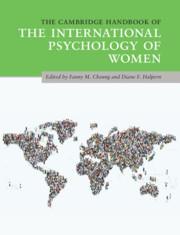Book contents
- The Cambridge Handbook of the International Psychology of Women
- The Cambridge Handbook of the International Psychology of Women
- Copyright page
- Dedication
- Contents
- Figures
- Tables
- Contributors
- Acknowledgments
- Section 1 The Underpinnings of Sex and Gender and How to Study Them
- Section 2 Developmental Perspectives of the International Psychology of Women
- Section 3 Cognitive and Social Factors
- Section 4 Work and Family Issues
- Section 5 Inequality and Social Justice
- Section 6 Health and Well-Being
- 31 Happiness across Cultures and Genders
- 32 Women under Pressure
- 33 Gender and Women’s Sexual and Reproductive Health
- 34 Physical Health
- 35 Women and Suicidal Behavior
- 36 Sex and Gender in Psychopathology
- 37 Women and Psychotherapy
- Epilogue Some Final Thoughts and Take-Home Messages
- Index
- References
37 - Women and Psychotherapy
“Women Hold Up Half the Sky”
from Section 6 - Health and Well-Being
Published online by Cambridge University Press: 20 July 2020
- The Cambridge Handbook of the International Psychology of Women
- The Cambridge Handbook of the International Psychology of Women
- Copyright page
- Dedication
- Contents
- Figures
- Tables
- Contributors
- Acknowledgments
- Section 1 The Underpinnings of Sex and Gender and How to Study Them
- Section 2 Developmental Perspectives of the International Psychology of Women
- Section 3 Cognitive and Social Factors
- Section 4 Work and Family Issues
- Section 5 Inequality and Social Justice
- Section 6 Health and Well-Being
- 31 Happiness across Cultures and Genders
- 32 Women under Pressure
- 33 Gender and Women’s Sexual and Reproductive Health
- 34 Physical Health
- 35 Women and Suicidal Behavior
- 36 Sex and Gender in Psychopathology
- 37 Women and Psychotherapy
- Epilogue Some Final Thoughts and Take-Home Messages
- Index
- References
Summary
This chapter highlights the relevance of women’s experience and the leadership that women play in psychotherapy. We briefly review contributions of women in transforming psychotherapy from a field dominated by male views to one being inclusive toward liberation, and empowerment and emancipation of women and culturally diverse clients in the West. We also present evidence of women’s leadership in psychological healing practice and professional development of psychotherapy around the world, using China and Guatemala as examples. As clients, scholars, or practitioners, women’s voices and experience have challenged traditionally gender-biased practice of psychotherapy. The feminization of the psychotherapy workforce demonstrates the degree to which women have stepped up and shouldered the responsibility for mental health care in the United States and worldwide.Framed in an international and contextual perspective, we recommend best practices for clients of all genders and cultures, especially women, to be growth-oriented, relationship-focused, and strength-based.
Keywords
- Type
- Chapter
- Information
- The Cambridge Handbook of the International Psychology of Women , pp. 526 - 540Publisher: Cambridge University PressPrint publication year: 2020
References
Suggested Readings

Changming Duan is a cisgender Chinese woman born and raised in China until after college when she migrated to the United States. She received her master’s degree from Canada and her PhD in Counseling and Social Psychology from University of Maryland in the United States. She is currently a Professor of Counseling Psychology in the University of Kansas. Her research interests include addressing multicultural and social justice issues in counseling practice and training, understanding culturally specific counseling process and outcome, and using strength-based counseling to promote psychological healing and growth. She is also interested in international collaboration in research and training.

María del Pilar Grazioso was born in Ecuador and raised in Guatemala where she attended college. She studied for her master’s degree in the United States and her PhD in both the USA and Argentina. She carries a multicultural identity, with Italian ethnic background from her paternal side and Spanish, French, Belize, Cuban, and Guatemalan origins from her maternal side. She is recently retired from the Universidad del Valle de Guatemala (UVG) where she developed graduate programs in Counseling Psychology, Mental Health, and Community Psychology. Currently she co-coordinates Proyecto Aiglé, Guatemala, is affiliated to Fundación Aiglé Argentina, and is a research affiliate both at UVG and at Mayan Health Alliance Wuqukawoc. She received the APA Division 52 Outstanding International Psychologist Award and the Award Ricardo Bressani, and was recognized by the Colegio de Psicólogos de Guatemala. She has served in several leadership positions in the Interamerican Society of Psychology, and as associate editor of the Wiley-Blackwell Encyclopedia of gender and sexuality studies. Her interests focus on counseling and community mental health, multicultural training, psychotherapy, supervision, gender and prevention, and child and adolescent assessment. She is family oriented and enjoys baking, jogging, music, reading, and nature.



